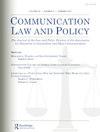Breyer, Stephen. The Uneasy Case for Copyright: A Study of Copyright in Books, Photocopies, and Computer Programs, 84 Harv. L. Rev. 281 (1970)
IF 0.2
Q4 LAW
引用次数: 0
Abstract
Copyright law is under constant pressure to evolve. Since the Copyright Act of 1790, which protected only maps, charts and books from unauthorized copying, the law has grown to cover dramatic and audiovisual works, music, choreography, pictures, graphics, sculptures, architecture and more. As emerging technologies have created opportunities for new modes of creative expression and distribution, copyright law has been forced to respond. It may seem curious then, that a law review article written fifty years ago — and primarily about book publishing — could have continued relevance today. This is particularly true considering it was published before the Copyright Act of 1976, which remains the primary basis of copyright law in the United States. Yet “The Uneasy Case for Copyright” continues to have a lasting significance for copyright scholars. It was the first piece Justice Stephen Breyer — then an assistant professor at Harvard Law School working toward tenure — published布雷耶,斯蒂芬。版权的不安案例:书籍、复印件和计算机程序的版权研究,第84卷。L.修订版281(1970)
版权法正面临不断发展的压力。自1790年《版权法》仅保护地图、图表和书籍不被未经授权复制以来,该法已发展到涵盖戏剧和视听作品、音乐、舞蹈、图片、图形、雕塑、建筑等。随着新兴技术为新的创意表达和传播模式创造了机会,版权法被迫做出回应。50年前写的一篇法律评论文章——主要是关于图书出版的——可能在今天仍然具有相关性,这似乎很奇怪。考虑到它是在1976年《版权法》之前出版的,这一点尤其正确,该法仍然是美国版权法的主要依据。然而,“版权不安案”仍然对版权学者有着持久的意义。这是斯蒂芬·布雷耶大法官发表的第一篇文章,当时他是哈佛法学院的助理教授,致力于终身教职
本文章由计算机程序翻译,如有差异,请以英文原文为准。
求助全文
约1分钟内获得全文
求助全文
来源期刊
CiteScore
0.60
自引率
33.30%
发文量
7
期刊介绍:
The societal, cultural, economic and political dimensions of communication, including the freedoms of speech and press, are undergoing dramatic global changes. The convergence of the mass media, telecommunications, and computers has raised important questions reflected in analyses of modern communication law, policy, and regulation. Serving as a forum for discussions of these continuing and emerging questions, Communication Law and Policy considers traditional and contemporary problems of freedom of expression and dissemination, including theoretical, conceptual and methodological issues inherent in the special conditions presented by new media and information technologies.

 求助内容:
求助内容: 应助结果提醒方式:
应助结果提醒方式:


